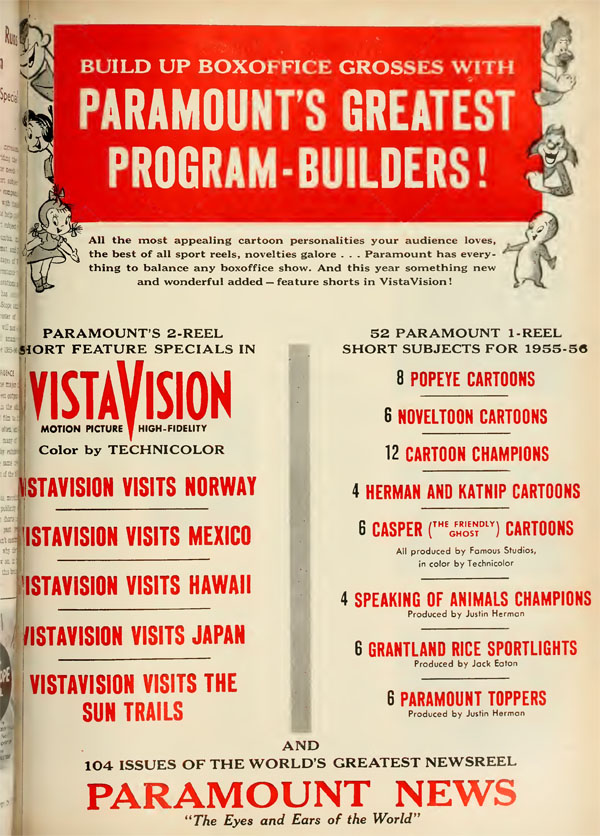
The 1955-56 season. This would be the final one for Famous Studios as we know it. Change was in the wind.
First, the good news – the annual option to extend the agreement between Paramount Pictures and Famous Studios (below) requires the usual deliverables of 24 pictures: eight Popeye, six Noveltoons, four Herman and Katnip and six Casper cartoons. Then, even better news: Paramount agrees to extend an additional ten option periods – guaranteeing production of cartoon shorts through the 1966-67 season. Considering the turmoil in the business, technological challenges and competition from television, this must have seemed like a sign of good faith in Kneitel and Sparber – who could now breath a bit easier. Or so it seemed…
But all was not as idyllic it seemed. In September, Paramount pressures Famous to essentially hand over its lease to its office space.
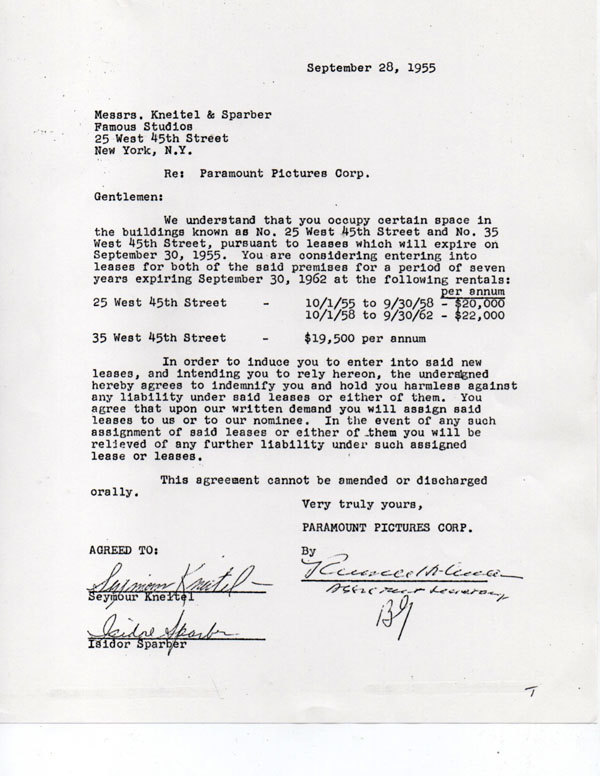
I’ve always been fascinated by the actual offices and working spaces of Famous Studios. Below is a great article by animator/storyman I. Klein that was published in Cartoonist Profiles #43 (September 1979). He writes about working at Mintz, Terrytoons and Famous. (click each page to enlarge)




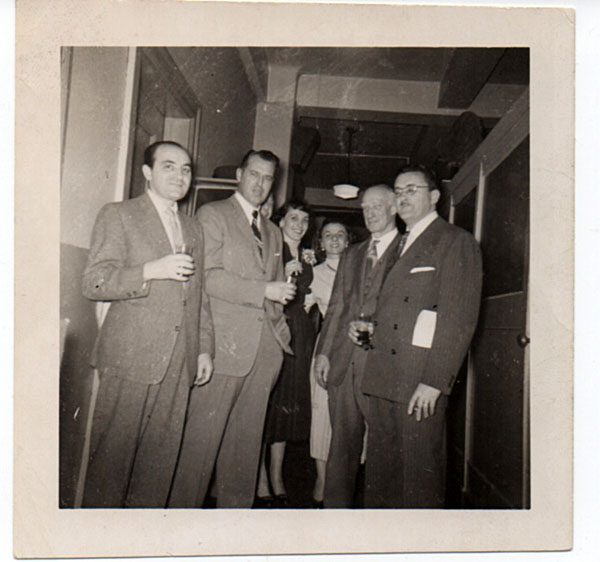
Rare photo snapped at a Christmas Party at Famous Studios on December 24th 1955. Left to Right: Harry Ryterbrand, Elsworth Barthen, Mary Zaffuto (Waldron), Marie Gallone, Jeff Price and Dave Tendlar.

This blurb appeared in the NY Animation Union’s newsletter, TOP CEL (January 1956).
I’ve only posted the two top pages of the Popeye contract below. The whole deal is complicated and detailed – and hundreds of pages long. The first 191 Popeyes (through the 1951-52 season) were delivered first. The rest were parceled out due to Paramount wanting to protect its theatrical rights to release and re-release them. The deal spelled out that the 1956-57 season would be Popeye’s last – and that Paramount’s theatrical rights to the last five years of the series would extend to December 31st, 1967.
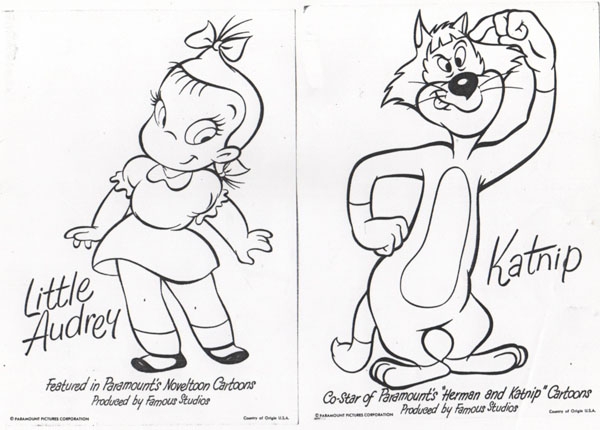
Two publicity stills released by Paramount to publicize their cartoon stars.
In June 1956, Kneitel and Sparber met with Paramount’s East Coast Production head Russell Holman who essentially informed them that due to their films losing money, Paramount wanted to break its existing contract with Famous and take over the studio itself. Kneitel and Sparber would be retained as Paramount executives to run the operation, but Paramount would now take in the revenues from comic books, merchandising and TV sales – with none of it going to Famous. Meetings about this would go on for the next several months – and we will discuss this further next week.
As for now, let’s take a look at the cartoons delivered for the 1955-56 season:
Eight (8) Popeye cartoons
MISTER AND MISTLETOE (9/30/55) Sparber/Eugster. Bluto disguises himself as Santa Claus in an effort to get close to Olive.COPS IS TOPS (11/4/55) Sparber/Johnson. Olive joins the police force – and Popeye tries to help her.
A JOB FOR A GOB (12/9/55) Kneitel/Eugster. Vacationing out west, Popeye and Bluto compete for a job on Olive’s ranch.
HILL-BILLING AND COOING (1/13/56) Kneitel/Johnson. In the Ozarks, Olive defends Popeye from a lonely love-sick hillbilly gal (who get’s her own cartoon next year, Possum Pearl).
POPEYE FOR PRESIDENT (3/30/56) Kneitel/Johnson. Popeye challenges Bluto in a race to become President of the United States.
OUT TO PUNCH (6/8/56) Kneitel/Johnson. Oliver trains Popeye for his big boxing match with Bluto. John Zago’s simple backgrounds begin to evoke the UPA stylings currently in vogue.
ASSAULT AND FLATTERY (7/6/56) Sparber/Eugster. A “cheater” with a clever premise: Bluto takes Popeye to court, suing him for battery. His defense? Stock footage from The Farmer and The Belle, How Green Is My Spinach and A Balmy Swami.
INSECT TO INJURY (8/10/56) Tendlar/Reden. Popeye tries to build a house despite an invasion of hungry termites.
Four (4) Herman and Katnip cartoons
MOUSIEUR HERMAN (11/25/55) Tendlar/Hudson. Herman and Katnip in an art school.
MOUSEUM (2/24/56) Kneitel/Eugster. Herman takes his nephews to a museum.
WILL DO MOUSEWORK (6/29/56) Kneitel/Golden. Herman tries to evict Katnip from his cozy home with a maid.
MOUSETRO HERMAN (8/10/56) Sparber/Eugster. Herman gets rid of Katnip so the mice can have a jam session.
Six (6) Casper cartoons
RED, WHITE AND BOO (10/21/56) Sparber/Waldman. Casper uses a scientists time machine to make friends in history.
BOO KIND TO ANIMALS (12/23/55) Sparber/Golden. Casper helps Spunky the donkey (remember him?) to find a useful job.
GROUND HOG PLAY (2/10/56) Kneitel/Golden. Comic strip character Casper helps Hillary the ground hog find his shadow – by becoming his shadow.
DUTCH TREAT (4/20/56) Sparber/Waldman. Casper befriends Little Hans in Holland.
PENGUIN FOR YOUR THOUGHTS (6/15/56) Kneitel/Golden. Casper returns a penguin to the South Pole.
LINE OF SCREAMAGE(8/17/56) Kneitel/Waldman. Casper teaches Little Billy to play football.
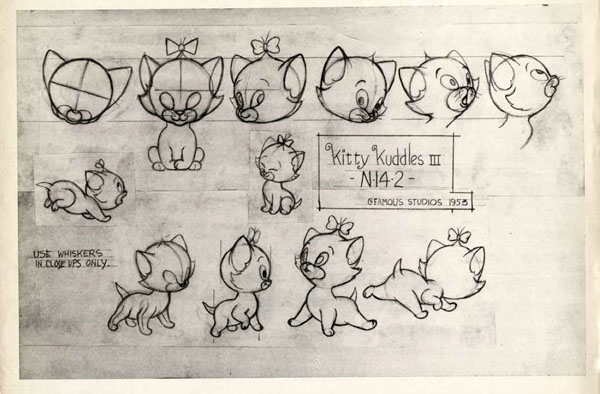

ABOVE: Model Sheets from “Kitty Cornered”
Six (6) Noveltoons cartoons
RABBIT PUNCH (9/30/55) Tendlar/Hudson. (Tommy Tortoise and Moe Hare) Tortoise and Hare compete in the boxing ring by making some changes in the script.
LITTLE AUDREY RIDING HOOD (10/14/55) Kneitel/Reden. (Little Audrey) Audrey brings a cake to Grandma’s house only to discover a burglar in her home.
KITTY CORNERED (12/30/55) Tendlar/Taras. (Kitty Cuddles) Snardley, a crooked butler, plots to kill Kuddles, a wealthy cat.
SLEUTH BUT SURE (3/23/56) Tendlar/Reden. (Tommy Tortoise and Moe Hare) Tortoise tracks down Hare who just escaped fro prison.
SWAB THE DUCK (5/11/56) Tendlar/Reden. (Baby Huey) Huey wants to play “pirate”. Huey wants to play “pirate”.
PEDRO AND LORENZO (7/13/56) Tendlar/Reden. A story about a Mexican boy and his pet bull.

Pedro’s papa from “Pedro and Lorenzo”
(Thanks this week to Ken Layton and Art Binninger)


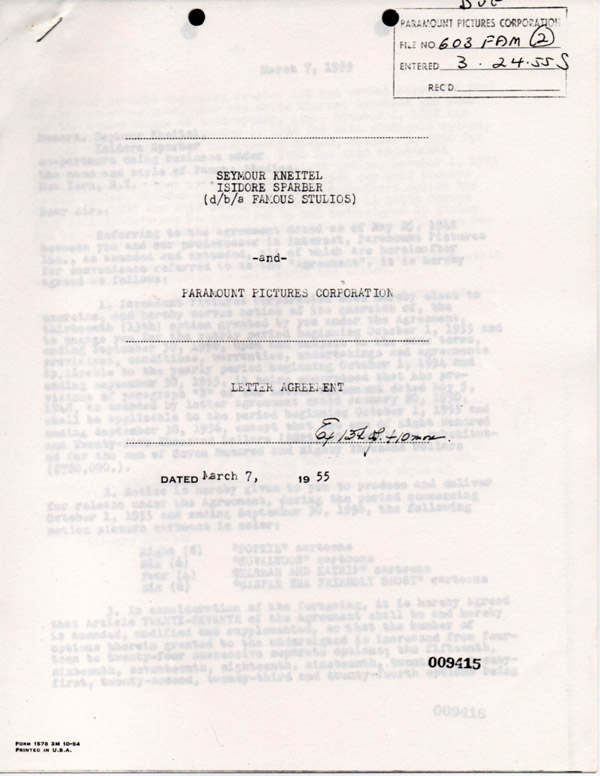

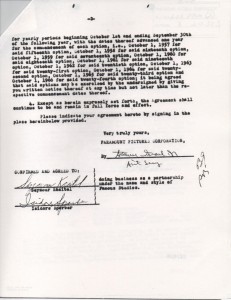
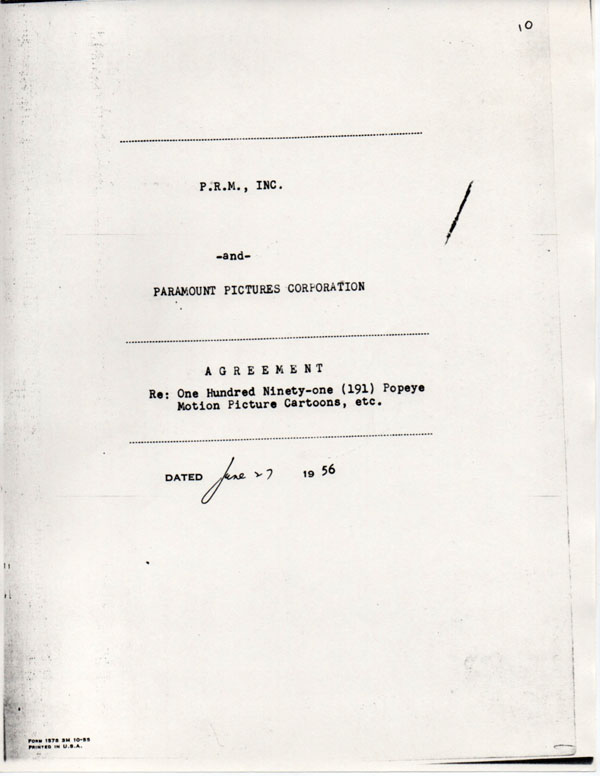


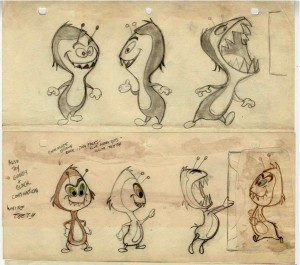
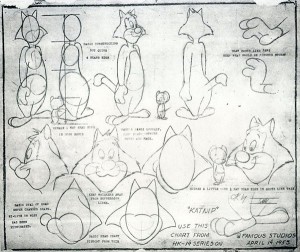
 Jerry Beck is a writer, animation producer, college professor and author of more than 15 books on animation history. He is a former studio exec with Nickelodeon Movies and Disney, and has written for The Hollywood Reporter and Variety. He has curated cartoons for DVD and Blu-ray compilations and has lent his expertise to dozens of bonus documentaries and audio commentaries on such. Beck is currently on the faculty of CalArts in Valencia, UCLA in Westwood and Woodbury University in Burbank – teaching animation history. More about Jerry Beck [
Jerry Beck is a writer, animation producer, college professor and author of more than 15 books on animation history. He is a former studio exec with Nickelodeon Movies and Disney, and has written for The Hollywood Reporter and Variety. He has curated cartoons for DVD and Blu-ray compilations and has lent his expertise to dozens of bonus documentaries and audio commentaries on such. Beck is currently on the faculty of CalArts in Valencia, UCLA in Westwood and Woodbury University in Burbank – teaching animation history. More about Jerry Beck [



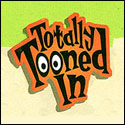



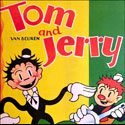
The office space agreement change, followed by Paramount taking full control of Famous, has a few echos of the deal with the Fleischers to move to Miami in a studio financed by Paramount, which later helped make the seizure of the studio and the creation of Famous easier.
(Also, from a non-cartoon angle, the rents for Famous’ buildings also are kind of funny to look at in hindsight, given they were less than a block off Fifth Avenue, and the rates were $1,600-$1,800 a month. Most small apartment-dwellers in Manhattan would kills for rents like that today.)
Paramount Champions reissues for the 1955-56 season:
“The Mite Makes Right”
“The Old Shell Game”
“The Little Cut-Up”
“Hep Cat Symphony”
“Little Red School Mouse”
“Leprechaun’s Gold”
“Quack-a-Doodle Doo”
“Teacher’s Pest”
“Tarts and Flowers”
“Pleased to Eat You”
“Goofy Goofy Gander”
“Saved by the Bell”
So thoughtful of you to include a list of VistaVision travelogues in your opening ad photo… since some of us don’t stay 100% focused on the cartoons. Ha ha!
One thing I am discovering is that, like the Warner and MGM ‘toons, a lot of these must have been completed much earlier than the title card copyright dates suggest. The lay out sheets here are dated 1953-54.
The reason many of the Famous Studio cartoons were in production years in advance of their release date was because the studio enjoyed the luxury of having a somewhat guaranteed 14 year period of option renewals (per the original 1942 agreement). Paramount had the right to order as many (or as few) shorts as they pleased and to dictate which series they wanted. This explains why some Noveltoons have model sheets with “Screen Song” production numbers. A certain number of Noveltoons and Popeye were a “given” each year. My guess is that the Popeye series would have halted this season (55-56) due to the AAP (PRM) deal, but didn’t stop because the studio had the next season already deep in production – assuming that Popeye would go on indefinitely. That was their bread-and-butter. Losing Popeye was, for Famous, literally a “game-changer”.
P.S. To clarify your other point, I actually included the VistaVision travelogues portion of the 1954-55 trade ad in the post last week. In case you didn’t see it, you simply had to read the caption which indicated “Click above to see entire the full-page advertisement” and then click on the ad itself. Ha-ha to you! 😉
I know… just fun mentioning it, on account of our lengthy “left turn, side-road” discussions before.
… and only Norway was covered last time! Now movie-goers get to see the “sun trails” of Arizona and Colorado on that gorgeous big screen. Giddyup! One of these days, some of us need to start a “Forgotten Short Subjects” Research to play “sister site” to the Cartoon one. You know… featuring blog posts about “Grantland Rice Sportlights made after Grantland died”…
It seems amazing that studios were cranking out short subjects at such a late date, especially newsreels. On the other hand, folks on another old movie forum pointed out that there was simply no television reception in much of the country — especially rural areas — until well into the 50s, so a market for newsreels lingered on.
Even in markets with television, big screen formats like VistaVision and simple color still offered some novelty and allure. Thus “Bugs Bunny Showboat” and “Tom and Jerry Festival of Fun”, as well as glossy travelogues.
Podunk America was sure eating it up! We tend to forget that as we think more to our big city folk!
On Hillbilling and Cooing this was the only time where the “tables were turned” instead of Popeye saving Olive Oyl it was Olive saving Popeye from Possum Pearl a muscular love crazed “mountain gal” or “she Hilbilly” who even Lil’ Abner would be afraid of! Note that the outfit that Possum Pearl wore the same outfit that the “Shrek-like” space aliens wore – with a addition of a straw hat for Pearl. And I wonder who did the voice of Possum Pearl?
And when UM&M bought out the pre 1950’s Paramount cartoons it was a precursor of the eradication of the Paramount name by literally “blacking out” everything that had Paramount’s name from the opening credits to the title cards. The A.A.P. bought Popeye cartoons slightly fared better by still keeping the Paramount name on several of the pre. 1950 Popeye cartoons.
And Pedro and Lorenzo was one of my favorite cartoons about a Pedro a young Mexican boy and Lorenzo, Pedro’s pet bull where he kept Lorenzo’s tooth after he accidentally knock it off. Pedro’s pop had to sell Lorenzo and Pedro was upset about it. Fast forward about 14 years later where Pedro was now a up and coming young Matador and was ready to enter the bullring where the bull that Pedro was ready to fight was Lorenzo! But the crowd in the bullring wanted action instead of a happy reunion so Pedro “killed” Lorenzo to please the audience (but in fact Lorenzo was very much alive and he and Pedro now lived happily ever after).
And when UM&M bought out the pre 1950′s Paramount cartoons it was a precursor of the eradication of the Paramount name by literally “blacking out” everything that had Paramount’s name from the opening credits to the title cards.
I would be surprised if UM&M wasn’t required to make those changes to the main titles of the films they bought. It wasn’t unusual. For example, when Hal Roach bought his film library back from MGM, MGM required Roach to remove all MGM logos and trademarks from the main titles of reissue prints.
Technicolor used to be very particular about how their name was used. Even if a film was originally shot in the Technicolor process, if prints were made up using any other process (say, Eastmancolor), then Technicolor would require that their company’s name be removed from prints.
Where companies like UM&M can be faulted is for making the title card changes they made on surviving original preprint material rather than on dupe negatives.
So the “Technicolor policy” is the reason why some prints of MGM cartoons had Technicolor blacked out “NTA Style”, not only on the “Metro-Goldwyn-Mayer presents” title cards, but on the MGM lions as well? And didn’t Paramount have a television network before the cartoons were sold off? If so, then why did Paramount decide to no longer allow their cartoons (and live-action shorts) to bear their respective distributor’s trademark?
UM&M, Harvey and PRM (AAP) were required by contract to eliminate all references to Paramount Pictures on the cartoons (and shorts).
From the Popeye contract, this passage:
Why? Because in the mid-1950s the heated competition between movie theaters and television was at its height. To appease theatre owners, the major studios intentionally did not sell their films directly to TV – and yet, TV was too lucrative to ignore. Middle-man distributors (like UM&M and AAP) sprung up and bought film libraries from the majors and presented their films with new “TV titles”. It wouldn’t have looked good to the theatre chains to have the Paramount logo appearing regularly on TV. They had to go.
However, as we know, the TV sub distributors occasionally slipped up and some prints of certain cartoons were never altered. The theatre chains never noticed, and home viewers couldn’t care less.
However, as we know, the TV sub distributors occasionally slipped up and some prints of certain cartoons were never altered. The theatre chains never noticed, and home viewers couldn’t care less.
We ought to be thankful for that Jerry. Nobody weren’t being litigious enough when those few prints slipped through the cracks.
That quote from the Paramount-A.A.P. contract is interesting in light of the fact that A.A.P. left the original Paramount copyright notices intact on all of the Popeye cartoons. Did Paramount change its mind a bit after this contract was made, or were the Popeye cartoons just really lucky and A.A.P. neglected to fully follow the contract?
What exactly does “P.R.M.” stand for, by the way? I gather that P.R.M., Inc. was once Pressed Metals of America, Inc., by the way.
I’ve never been able to find any info on what P.R.M. stood for – but it was Eliot Hyman’s company which (it seems) almost immediately changed to A.A.P. within a month or two of making the Popeye deal.
With the exception of the last season (56-57) of Popeye cartoons (which were delayed from TV broadcast for a year or so) most (99%) of the Popeye cartoons went to TV with replaced main and end titles which eliminated the Paramount mountain trademark. As for the copyright notice – apparently no one noticed and no one at Paramount enforced this. As with the UM&M and Harvey deals, is was supposed to happen with AAP. There is no existent record as to why this didn’t happen, but it can be assumed that AAP figured they could get away with just changing the front and end titles – and they did.
Possum Pearl was “Park Ave. Hillbilly” Dorothy Shay! (source: ANIMATED FILM ENCYCLOPEDIA, Graham Webb, 2000, McFarlane Press,).
I’m interested in why the Boop cartoons never really caught on, at least where I came from, Indianapolis. I never saw a Betty Boop cartoon on television in the late 50s, early 60s, but there was a show, Happy Herb the Sailor, dedicated to Popeye, and there were plenty of Famous Cartoons, but I don’t remember Little Lulu, but do recall Little Audrey. Did the legal problems with Boop/Fleischer prevent airing of Boop during the golden age of black and white cartoons on TV? And were there still Lulu legal problems? It seems odd that there were around a hundred Boop cartoons, that were similar to Popeye, and yet they didn’t air. Comics had already discovered that Wonder Woman was a winner, forming the triumvirate of Superman/Batman/Wonder Woman for D.C., being the only real survivors of the comic book superhero purge of the late 40s/early 50s.
Apparently, they simply didn’t air in Indianapolis. There were no legal problems preventing the Betty Boop and Little Lulu cartoons from being televised. Based on what you say above, apparently none of your local stations bought the UM&M cartoon package – but picked up the AAP Popeyes and Harveytoons package that featured Audrey and Casper.
The UM&M package which included Boop and Lulu also contained the Fleischer Color Classics, the early Talkartoons and Screen Songs, Gabby cartoons and the George Pal Puppetoons. All of that aired in New York City when I was a kid.
I’m sure it came down to which stations picked up which and for what market. My town only barely got two stations on the air by the end of the 50’s and even I don’t know what was played unless I checked the local listings for that time period, but I’m sure the AAP package was picked up. I’m sure a station in Detroit probably had the UM&M library anyway so there wasn’t a shortage there if you could pick up those stations 60 miles away. Either they’re listed by name in the program, or those shorts were included in a program produced locally featuring a cowboy, or a clown, or a space cadet or whatever. That’s just the way things were thing (on the receiving end of course). I suppose it’s a shame nobody in Central Indiana saw an interest in the Fleischer Studios output to broadcast over the airwaves then.
It’s probably also worth noting that ths ’55-’56 season’s “Pedro & Lorenzo” was Famous’ last try at doing a cartoon that wasn’t pure comedy, and leaned more towards Disney-style sentiment.
The effort to mimic Walt’s cartoons was highest during the Fleischer Color Classic days, but continued to pop up periodically during Famous’ first nine years of operations with the Raggedy Ann shorts, “The Wee Men” and the Land of the Lost trilogy. From here on, Paramount’s efforts would be 100% aimed at laughs and not at sentiment (Eddie Lawrence’s “Abner the Baseball” from 1961 being about the closest thing to a more narrative/less gag oriented cartoon to show up in the studio’s final decade).
It is sad to see it go at this point. I guess Pedro and Lorenzo could be seen as a swansong in that regard.
When I was a kid, I got my television from major market stations, wherever we lived.
Back in Chicago (where we lived until 2/14/60), one station (WGN, Channel 9) had the AAP and the UM&M packages. One of their shows would get the “Little Lulu” and “George Pal Puppetoons” cartoons, and another one would get the “Pepeye shorts. I can distinctly remember seeing “The Hungry Goat” (1943) and “Mess Production” (1945) in Chicago, along with openings of both “Little Lulu” and “Puppetoon” shorts.
When we moved out here (effective 2/17/60), KTLA (Channel 5, which was owned by Paramount Pictures at the time), had both the NTA and the AAP packages. Of the NTA’s, they were more likely to run the “Noveltoons”, the”Stone Age” cartoons, the “Color Classics” (in monochrome, natch!) , and the ‘Gabby” shorts. I can remember them running many shorts, often by the songs featured.
KTLA gave the “Popeye” cartoons special treatment, through the “Pier 5 Club” hosted by Tom Hatten. He not only hd the AAP package, but the made-for-television KFS package as well. The two-reelers would get run as special treats, and every Thanksgiving would bring a showing of “Gulliver’s Travels”.
I don’t know if the UM&M package of Paramount shorts ran much here in the 1950’s. (I wasn’t here that early). But, around 1965, KCOP (13), the weakest of the VhF stations, picked up the “Betty Boop” shorts for an eight-thirty ayem half-hour. I can remember the early one with “wheat cakes!” being run, and I can remember seeing “Betty Boop’s Little Pal” with an MPAA “egg’ at the beginning of it.
While I was out here, we never saw the “George Pal Puppetoons”. And nobody had the “Superman” shorts. Nor were we likely to see the pre-Boop “Talkatoons”.
Pedro’s father looks a lot like an animated version of actor Trevor Bardette.
Pedro’s father was voiced by Jackson Beck and Mae Questel did the voice of young Pedro and I believe that Jack Mercer did the voice of Pedro now as a young matador.
Say what you will about the Famous output but ya gotta love the wickedly expressive model sheet for Snardley the Butler. I’d enjoy watching a loop of just his evil facial expressions.
My take on the POPEYE/ BOOP situation….as various stations had the rights to various POPEYEs had specially created TV slots, often with nautical themes ( in Detroit/ Windsor we had CAPTAIN JOLLY and esp POOPDECK PAUL for Popeye), finding a slot for Boop was an altogether different challange….they quite routinely mixed Fleischer, Famous and King Features output and so had a more modern feel, whereas Boop was kinda stuck in the “old fashioned” 30s….same thing with old Terrytoons which turned up in less than ideal timeslots..
In Duluth, Minnesota, WDSM-TV (now KBJR) had the market cornered on cartoons in the late 50’s-early 60’s. They ran both the AAP Popeye and Warner Bros. packages, plus NTA’s Betty Boop, Little Lulu, George Pal, etc. (and even “Speaking of Animals” in various kid shows, mainly “Captain Q,” played by station weatherman Jack McKenna.
By the mid-60’s, McKenna and Captain Q were gone, replaced by new weatherman Ray Paulsen as a local version of “Bozo the Clown,” and the Bozo cartoons and new King Features all-color Popeyes replaced the older packages. Sometime in between, WDSM also bought and ran the bootlegged black and white “Krazytoons” package.
Around 1970, WDSM ended the Bozo show, with Paulsen continuing as a new clown character, “Mr. Toot”…over which they were sued by Larry Harmon. About this time, they brought back the AAP Warner package and added the Harveytoons.
As for the other area stations, KDAL-TV (now KDLH) got by for years on the Screen Gems package of Van Beuren and Krazy Kat…and when they moved to new color studios, literally dumped them in the garbage can (ouch.) KDAL was never nearly as successful in the kid show area as WDSM. A third station, WDIO-TV, started in the mid-late 60’s with some of the NTA color cartoons (Little Lulu and Noveltoons, George Pal…by then minus the “Jaspers”…but no Max Fleischers) and the UPA package derived from the McBoing Boing show, which, being in a variety of odd lengths, were also valuable “fillers” for their extensive showings of feature movies.
Am I right in remembering that ABNER THE BASEBALL was a two reeler ?
Yes, it’s roughly twelve-and-a-half minutes long, because it’s an adaptation of a comedy record.
http://irvspector.blogspot.com/2010/03/abner-baseball-little-pepper-in-their.html
https://www.youtube.com/watch?v=uq0pOspesfQ
ABNER THE BASEBALL was double the length of a standard Paramount cartoon at that time… which is to say (as Bobby does above) 12 minutes. Not quite what we would consider a “two-reeler”, but essentially a longer length subject.
I was wondering, where could I find the full original english version of Pedro and Lorenzo. I just loved it!